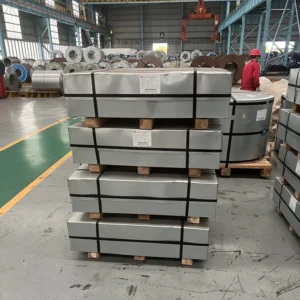Introduction to Cold Rolled Grain Oriented Steel
Cold rolled grain oriented steel, often abbreviated as CRGO steel, is a specialized type of electrical steel developed specifically for applications in transformers and other high-efficiency electrical equipment. It has a unique crystalline structure that ensures the magnetic flux flows more easily in the rolling direction, significantly reducing core losses and enhancing transformer efficiency. This makes it an essential material in modern power transmission and distribution systems, particularly in regions where energy efficiency and reliability are top priorities, such as Europe, North America, and the Middle East.
Production Process and Material Characteristics
The manufacturing process of cold rolled grain oriented steel involves several sophisticated steps designed to produce a highly oriented grain structure. The process typically begins with hot rolling slabs of low-carbon steel, followed by cold rolling to reduce thickness while maintaining surface quality. Special annealing techniques are then applied to align the grains, ensuring that the steel’s magnetic properties are optimized.
One of the defining characteristics of cold rolled grain oriented steel is its very low core loss, which is a direct result of the grain orientation achieved during production. The steel also exhibits high magnetic permeability, meaning it can carry magnetic flux with minimal energy loss. These properties are critical for transformer cores, as they directly influence operational efficiency and heat generation.
Advantages in Transformer Applications
Transformers built with cold rolled grain oriented steel benefit from superior performance, including lower energy losses, improved operational efficiency, and extended service life. This is especially important for power grids in Europe and the Middle East, where energy efficiency standards are becoming increasingly stringent.
Key advantages include:
- Reduced Core Losses: The steel minimizes eddy current and hysteresis losses, making transformers more efficient.
- High Magnetic Permeability: This allows for smaller and lighter core designs without compromising performance.
- Improved Thermal Stability: The steel can withstand high operating temperatures, reducing the risk of material degradation.
- Longevity: With less heat generation, transformer insulation systems last longer, reducing maintenance and replacement costs.
Applications in Global Power Infrastructure
Cold rolled grain oriented steel is widely used in the core construction of power transformers, distribution transformers, and certain types of electric motors. Its role in improving grid efficiency is especially valuable in the Middle East, where expanding power infrastructure must meet the demands of rapidly growing cities, and in Europe, where aging grids are being modernized for renewable energy integration.
In addition to utility applications, cold rolled grain oriented steel is also found in industrial power systems, railway traction transformers, and specialty equipment where consistent and efficient power conversion is critical.
Global Market Trends and Demand
The demand for cold rolled grain oriented steel continues to grow due to the increasing focus on energy efficiency, environmental regulations, and renewable energy projects. As wind and solar power plants connect to national grids, the need for highly efficient transformers is more important than ever. This trend is driving investments in high-grade electrical steels, with manufacturers in Asia, Europe, and North America ramping up production capacity to meet global needs.
The Middle East, with its ongoing infrastructure expansion, is emerging as a key growth region. The Gulf Cooperation Council (GCC) countries, in particular, are investing heavily in power grid upgrades, smart grid technology, and high-efficiency transformers — all of which rely on cold rolled grain oriented steel.
Technical Standards and Grades
Cold rolled grain oriented steel is available in various grades, often classified by their maximum core loss values and thickness. Higher grades, sometimes referred to as Hi-B or laser-scribed grades, offer even lower losses and better performance in demanding applications.
International standards such as IEC 60404, JIS C2553, and ASTM A876 specify the properties, tolerances, and testing methods for this steel, ensuring that manufacturers and end-users can rely on consistent quality.
Challenges and Innovations in Production
Producing cold rolled grain oriented steel is a complex process that requires strict control over chemical composition, rolling schedules, and annealing conditions. Even small variations can affect grain orientation and magnetic performance. As a result, manufacturers continuously invest in research and development to refine production techniques.
Recent innovations include laser scribing technology, which further reduces core losses by creating artificial domain boundaries in the steel. This approach improves transformer efficiency without increasing material thickness or weight, making it a preferred option in high-performance designs.
Sustainability and Environmental Benefits
Using cold rolled grain oriented steel in transformer manufacturing supports environmental sustainability in multiple ways. The reduction in core losses translates directly into lower energy consumption across the power grid. This not only reduces greenhouse gas emissions but also lowers operational costs for utilities and industrial operators.
Moreover, the recyclability of electrical steel ensures that end-of-life transformers can be processed and reused, reducing waste and conserving natural resources.
Conclusion
Cold rolled grain oriented steel is an indispensable material in the global energy sector, combining advanced magnetic properties with durability and energy efficiency. Its role in enhancing transformer performance makes it a cornerstone of modern power transmission and distribution networks in Europe, North America, and the Middle East.
As the world moves toward more sustainable and efficient energy systems, demand for high-grade cold rolled grain oriented steel will continue to grow. For manufacturers, utilities, and infrastructure planners, investing in this material is a step toward building a smarter, greener, and more reliable power grid.
If you want, I can also prepare a set of optimized meta description, URL slug, and internal linking suggestions for this blog so that it’s ready for direct publishing and indexing. This will help boost rankings for Europe and Middle East searches.




